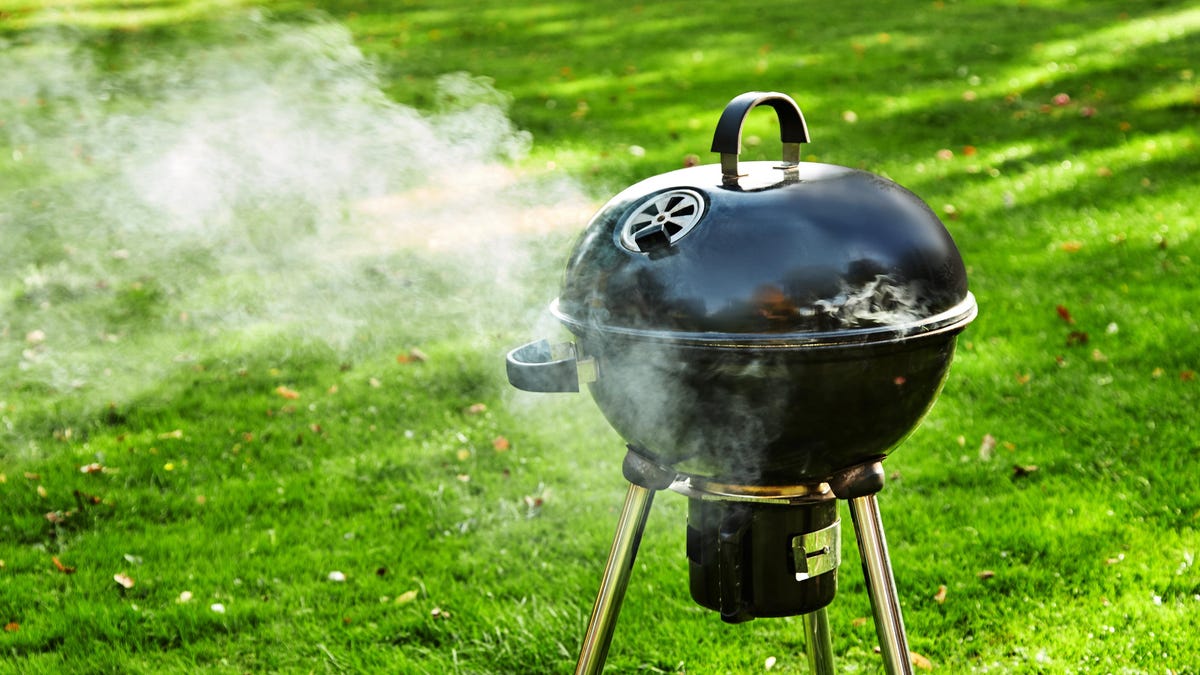
Grilling can be intimidating. It tends to be fairly male-dominated, though I will say that BBQ dudes are much more chill, welcoming, and helpful than sous-vide dudes, who tend to be pedantic and slightly unhinged. But community aside, it can be hard to know where to get started. The first question you need to ask yourself: gas or charcoal?
My father is good at a lot of things—veterinary medicine, fly tying, telling the same story over and over without it getting boring—but cooking is not one of them. He can manage a little grilling, but now that he knows what I am capable of, he rarely attempts to grill anything for me. I came into grilling on my own, without the guidance of a BBQ Dad, and it was an area of cooking I avoided for quite some time. But then I got a Weber Kettle, and became the BBQ Dad I needed. With it, I’ve smoked pork butts, whole turkeys, and lamb shoulders, and grilled some pretty excellent pizzas, pickles, and blood pumpers, as well as more mundane foods like chicken and steak. This is all to say I have a bit of a charcoal bias, but even I can admit that propane and propane accessories are a better fit for some people.
Why do you want to grill?
There are several reasons to get into grilling, and they are all valid. Maybe you want to feast on hot dogs and hamburgers all summer, or want to avail yourself of real BBQ. Perhaps you dream of grilled summer vegetables, or maybe you’re just tired of heating up your kitchen during these sweltering summer months, and want to take it outside. You can use either charcoal or gas to do all of these things, but each has its strengths (and weaknesses).
One is much cheaper than the other
You can buy a really nice charcoal grill—that can also function as a smoker—for under $200, and a serviceable one for around $50. A gas grill has more moving parts and components, and is therefore more expensive. Serious Eats reckons that a “decent” gas grill will run you at least $500, though it’s worth noting that the grill heads at AmazingRibs.com gave this $200 gas grill its coveted “Platinum” seal of approval.
Unless you inherit a gas grill from someone, charcoal’s lower cost of entry makes it a good choice for those who “aren’t even sure if they like grilling,” or are just looking for a cheap way to BBQ this summer.
Charcoal provides better flavor during long cooks
Charcoal generates smoke, and smoke is one of the things that gives food that classic grilled flavor. But, as Serious Eats points out, smoke isn’t the only source of flavor when grilling, especially when you’re working with short cook times:
Propane or natural gas burns relatively clean. The by-products of their combustion are mostly just water vapor and carbon dioxide. Charcoal, on the other hand, produces a whole host of other molecules, some of which can indeed land on your food and flavor it. At the same time, there’s a competing source of flavor: vaporized drippings from your food. The little sizzles, pops, and flare-ups you get as your burger drips juices (mostly fat, water, and dissolved proteins) onto the hot grill burner bars or coals. As those proteins and fats burn up, they create new aromatic compounds that get deposited right back onto your meat as it cooks. This happens regardless, whether your heat source is charcoal or gas.
For foods that are cooked quickly over direct heat—like burgers, sausages, and vegetables—you probably won’t notice a difference in flavor between charcoal and gas—the smoke won’t have enough time to impart very much flavor, but those pops and sizzles will. But for slower-cooking proteins like brisket, chicken, pork shoulders, ribs, or even thick steaks, you want the smoke from the charcoal, especially when you consider that those things are mostly cooked using indirect heat (away from the heat source), and do not benefit as much from flare-ups and vaporized drippings.
Smoke obviously has one drawback: It smells, and it makes you smell. I have never not wanted a shower after cooking with charcoal, but between powerlifting, hot tubbing, gardening, and general greasiness, I already shower at least twice a day during the summer, so this is not an issue for me.
Charcoal is also dirtier, and creates ash, which has to be disposed of. There is no such byproduct with a gas grill, but that does not mean you don’t have to clean the grates, or any gunk that drips down below the grates. And, even though a charcoal grill requires more routine cleaning, it is much easier to deep clean a neglected charcoal grill than it is to clean a neglected gas grill, so be honest with yourself and your level of laziness when making your decision.
Gas is far more convenient
It is very easy to get a gas grill “going.” Turn the knob and press the little lighter button. It’s on, and it gets hot very quickly (about five to 10 minutes). A charcoal grill takes at least half an hour to get hot, even if you use a chimney, and it’s also much messier. If your goal is to quickly cook proteins and vegetables during the week with minimal fuss and cleanup, a gas grill might be the grill for you.
Temperature control is also easier on a gas grill—just adjust the knobs—and they’re easier to maintain at a specific temperature. Even the most uniform charcoal briquette isn’t capable of burning as consistently as gas set to a specific flow rate. Controlling the temperature on a charcoal grill requires manipulating the air flow. There’s a bit of a learning curve involved, but I think it is worth mastering, particularly when you consider that…
Charcoal offers a much wider range of temperature
Charcoal grills not only get much hotter than gas grills, they can also maintain much lower cooking temperatures. According to Serious Eats, a gas grill has a temperature range or around 225°F to 600°F, whereas a charcoal grill can run from “as low as you want to 1200°F and up.”
Gas grill manufacturers will try an confuse the issue with BTUs, a unit of measurement that Meathead of AmazingRibs.com deems “useless”:
It is very hard to tell how much heat a gas grill will deliver because the manufacturers only tell you BTU, British Thermal Units, used. It is a useless number. BTU is just a measure of how much gas is used, like mpg in a car. Not very helpful if you want to know what top speed is. The number you want is called the “heat flux” which is the BTU per square inch of primary cooking surface (the secondary surface, the warming rack is not included). You have to calculate this yourself in order to compare potential heat from one grill to another (although we do that for you in our Equipment Reviews database).
So charcoal grills will run much hotter (and cooler) than their gas counterparts, but, with the exception of searing the absolute heck out of something, there are very few instances when you’ll need the temperature to rise above 600℉. I do, however, like having the option.
Wanna smoke?
I have had great success using my Weber Kettle as a smoker. As I mentioned earlier, I’ve been able to smoke turkeys, pork shoulders, and lamb shoulders on it using the snake configuration, to excellent results and rave reviews. You do have to fiddle with the vents a bit to keep the temperature stable for long, low, and slow cooks, but my fellow BBQ Dads* know that this is a feature, not a bug, as the smoker will keep you “too busy” for chores and tasks that take more than half an hour to complete.
[*This is a gender-neutral term.]
Weber Kettles and other similarly designed charcoal grills make great smokers because they seal up super well, creating an environment for the smoke to hang out in and actually flavor your meat and build a bark. All you have to do is toss some wood on the hot coals.
You can technically smoke with a gas grill by wrapping the wood chunks in foil and placing them below the burners, but they just don’t seal well. As Serious Eats explains, that’s a good thing for safety but a bad thing for smoking:
A gas grill, on the other hand, doesn’t seal particularly well. This is by design and is intended as a safety measure. A gas grill’s burners will spit out gas whether they’re actually burning the fuel or not—so what would happen if you were to completely seal a gas grill? Eventually, all the oxygen inside would be used up and the flames would die out, but gas would keep on pumping, filling the entire grill with highly combustible fuel. All it would take then is a tiny spark, and BOOM.
Because of this, getting smoke flavor into your meat—even with long-cooking foods and a whole bundle of wood chunks—is difficult with a gas grill.
Wanna sear?
A gas grill will give you more distinct grill marks, but that’s not a good thing. Those dark strips indicate where the Maillard reaction has occurred, and the Maillard reaction is the chemical reaction between amino acids and sugars that gives “browned” food its distinct, delicious flavor. (If you have a hard time imagining what that tastes like, think of toast, a roasty toasty potato, or the crust on a steak.) Thin strips of browning mean thin strips of flavor.
With a charcoal grill, your food is seared by the direct, radiant heat of the coals. The hotter and closer they are to your food, the better sear you’ll get. The grates hold the food, and provide some direct heat, but the coals are doing most of the work.
Gas grills are kind of the opposite. The flames heat the grates, which then sear the food (in thin strips) by way of conduction. You can mitigate this and promote a greater area of browning by keeping your food moving and exposing the pale areas to the hot grates, or you can get a gas grill with an infrared burner, but those are expensive, and rarely big enough to sear a bunch of steaks at the same time.
How big should you buy?
If you live in a suburb with a big back yard and normal HOA (or no HOA at all), you should feel emboldened to purchase the biggest, most obnoxious grill your money can buy. But if you live in an apartment, or condo, or any sort of dwelling that doesn’t allow for a lot smoke billowing around, you may have to scale your grilling aspirations to fit your life. The good news is that there are several grills—both gas and charcoal—that fit into smaller spaces. The grill heads at AmazingRibs.com recommend the Weber Go-Anywhere portable gas grill, as well as the charcoal version, and I am fond of the Smokey Joe.
With any grill, you want to make sure it’s big enough for two-zone cooking—you need ample space for a heat source on one side, with enough real estate left over to give your food some distance from that heat source. Why? Anything besides your quick-cooking burgers, dogs, and thin cuts of meat and veggies will need to be cooked by convection, with hot air circulating around the food. Think of a chicken thigh: You can sear it all you want, but if your only source of heat is scorching and direct (be that a cast iron pan or hot coals or grates), you’re going to burn the outside long before the flesh is cooked to a safe and edible temperature. Simply put: Your chicken (or ribs, or thick steaks, or root vegetables) need a place to get away from the direct heat—while still enjoying the warm circulating air inside the grill—so they can reach their full, delicious potential without getting burnt to shit.
Putting it all together
As you can see, there are a lot of factors that go into picking a grill, but there are three main questions you need to ask yourself before impulse-purchasing something from the Home Depot parking lot:
- What’s my budget? A fancy charcoal grill can be acquired much more cheaply than a fancy gas grill.
- Where am I going to put it? How much space do you have? Do you want to be able to take it to the park, the beach, or camping? Are you even allowed to have a grill at your condo?
- What do I want to cook? Gas grills are great for quick-cooking weeknight meals and classic burgers and hot dogs. Charcoal grills make better smokers, and are better suited for those looking for weekend “projects.” Charcoal also provides better flavor via smoke, but that flavor is only really noticeable during longer cook times that utilize indirect heat.
In addition to answering these questions, you’ll want to make sure the grill seals well, and has a well-constructed venting system, an easily adjusted temperature control apparatus, and enough room on the grates to allow for two-zone cooking.
Product review is not my bag, but AmazingRibs.com has an incredible, searchable database where you can read their reviews of grills, smokers, and all sorts of outdoor cookers. I’m already a dedicated Weber Kettle bitch, and I don’t see that changing anytime soon, but it’s still fun to look. And no matter what kind of grill you buy, please make sure you also purchase an external thermometer of some kind. The little dial thermometers that sit on top of your grill are notoriously inaccurate, no matter how expensive your grill was.
Credit: Source link



